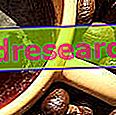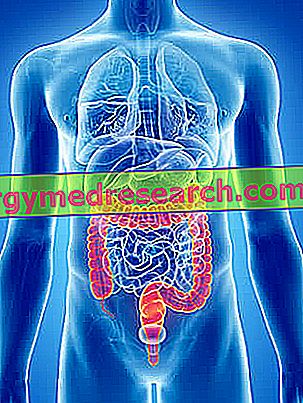Caffeine belongs chemically to a group of substances called "purines" (the chemical term is 1, 3, 7-trimethylxanthine), naturally occurring in coffee beans, tea leaves, chocolate, cocoa and cola seeds (an African plant).
Caffeine is often added to carbonated beverages and to many drugs or supplements sold without a prescription. In nature there are sixty-three species of plants containing caffeine.
Effects of caffeine
Although the ergogenic effects of caffeine have not yet been fully clarified, it now seems certain that they are mediated by the release of catecholamines. These hormones are called adrenaline and noradrenaline or epinephrine and norepinephrine respectively. Their action, maximum during a fright or a sudden and intense effort, acts both centrally and peripherally. To prepare the body to sustain this great psychophysical commitment, the catecholamines:
- increase coronary flow (increased blood supply to the heart)
- increase cardiac output (increased blood supply to tissues)
- increase systolic blood pressure
- increase muscle, renal and cutaneous blood flow
- increase metabolism
- increase glucose production (glycogenolysis) and lipolysis
- block adenosine receptors of fat and nerve cells (lipolytic and stimulating effect)

Diet and caffeine
In the United States 45% of the caffeine taken comes from coffee other important food sources of caffeine are represented by tea, cola-type drinks, energy drinks, medicines (diuretics, slimming and painkillers in particular).
Average caffeine content in commonly used beverages | |
| COFFEE' | 50-100 mg (one cup). |
| COKE | 40 mg (one can) |
| THE | 28 mg / 150 ml (the greater the longer the infusion is) |
| COCOA | 100 mg / 100 g |
| RED BULL | 30 mg / 100 ml |
| Guarana | 4-12% by weight (1 gram of guarana contains from 40 to 120 mg of caffeine |
PLEASE NOTE: in athletes it is necessary to take into account the summative effect of caffeine taken with the various foods so as not to exceed the limits imposed by the anti-doping regulations. The caffeine content of traditional mocha coffee is higher than in espresso In women, the use of some contraceptives (ethinyl estradiol) increases the duration of action of caffeine by about 50%. Some drugs have a high caffeine content (100-200 mg per tablet) | |
The diet is able to influence the individual response to caffeine. The different sensitivity towards this substance could therefore also be explained by analyzing the eating habits of those who take it. We have seen, for example, that caffeine in coffee has lower ergogenic efficacy than that sold in tablets. Fat mobilization resulting from caffeine ingestion is lower in individuals taking high amounts of carbohydrates in the pregara meal. Very important is also the addiction to the substance, that process by which the body develops a sort of resistance towards its pharmacological action. To maximize the ergogenic effects of caffeine, the athlete should therefore refrain from consuming caffeine-containing foods, drugs and beverages in the four six days preceding the competition.
The word to science
Although not all studies confirm the ergogenic effects of caffeine, most of them enhance these characteristics, even at low doses. Let's see some of them:
in one study, some athletes who had taken caffeine at high doses (10 mg / kg body weight) had a performance 19% higher than that of other athletes treated with placebo or under control conditions. The test consisted of a treadmill exercise that lasted until physical exhaustion.
Other studies have shown that the maximum ergogenic effect of caffeine is obtainable through dosages in the order of 5 mg / kg. At these doses, the concentration of caffeine in the urine was even lower than the limits imposed by the IOC.
Higher quantities do not seem to bring significant improvements in athletic performance.
The effects of caffeine on the muscular system are maximum for medium intensity exercises. On the other hand, no positive effect on potency or maximal strength has been demonstrated.
Caffeine intake
To maximize the positive effects it is recommended to take 3 to 6 mg of caffeine per kg of body weight, from 180 to 75 minutes before the sports competition. Small doses can also be taken during endurance performances, for example in view of the finish line.
Given the great individual variability, it is a good idea to experiment with the use of caffeine in training, avoiding taking it during the three days preceding the competition. Due to possible side effects it is recommended to consult a doctor before use.
Anti-doping controls
Because of its ergogenic effects, caffeine cannot be taken freely by athletes. The anti-doping authorities have in fact set recruitment limits, beyond which the use of this substance is considered doping and as such punished with the disqualification of the athlete.
One subject is positive for doping controls when the caffeine concentration in urine exceeds 0.012 mg / ml (= 12mcg / ml) *. It is not easy to determine exactly what the intake dose can exceed this threshold, given that caffeine is metabolized by the liver at different speeds from individual to individual (a bit like what happens with alcohol). This limit value can be reached, in broad terms, by taking 800-1200 mg of pure caffeine or 8 cups of strong coffee.
For this reason it is advisable not to exceed 6-8 cups of espresso or two to three cups of traditional coffee in the three hours preceding the competition. It is also important to pay particular attention to the possible additive effect (simultaneous intake of energy drinks, coffee and drugs or other caffeine-based drinks).
Side effects

In the case of doses higher than 500-1000 mg, cardiac rhythm abnormalities may also appear (tachycardia and ventricular extrasystoles). The LD-50 of caffeine (lethal quantity for 50% of the population), corresponds to 150 mg / kg of weight, a good thirty times above the recommended values.



